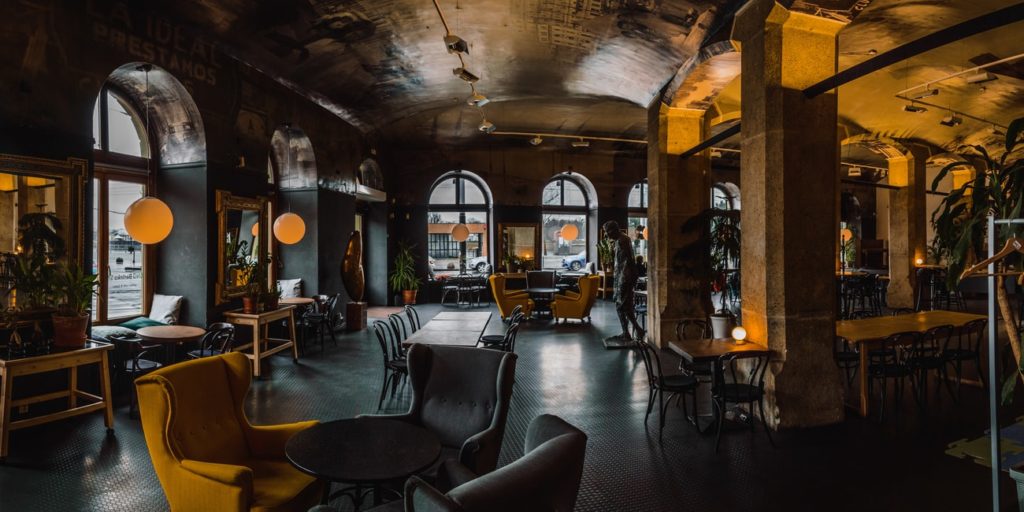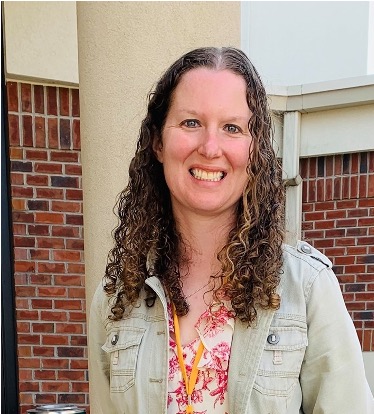Maybe you remember them too.
I remember the days of sitting in the places where my sermon-juices most easily used to start flowing. I remember the plastic booths and tables, background music and conversation, flavored coffee, and chocolate chip bagels. I remember the meetings and lunches and opening the Bible at tables. I remember the words popping out of my mouth “why don’t we meet at Starbucks tomorrow? What time works for you?”
I remember what life and ministry used to be like in the Third Places. Do you?
If you’re not familiar, the term ‘Third Place’ first appeared in the book The Great Good Place, coined by sociologist Ray Oldenburg in the late 1980s. He describes three main ‘places’ in society where people spend their lives, the first place being home, the second place as work, and the third places/spaces as those hospitable environments that cultivate social connection. Third Places are where people meet to make friends, discuss issues, and relax—places like coffee shops, gyms, eateries, bars, sports clubs, community centers, and playgrounds. Third spaces are very important in our quest for community. For those of us who are pastors and pioneers, they’re also deeply connected to ministry. Many fresh expressions of church start in Third Places, around groups of people who gather there, whether around an affinity or idea.
But of course, it’s been months since most of us have written a sermon or held a meeting in a coffee shop or restaurant. I can only faintly remember the last physical gatherings of the fresh expressions of church I have started– a Dinner Church and a hiking ministry. Things have changed—and I believe not only temporarily. Even with Third Places beginning to reopen, it’s hard not to notice there has been a change, an alteration and adjustment in how we do life and where we spend it.
A shift has taken place.
A shift IS taking place.
Perhaps this shift is best evinced by a drastic change made by Third Place forerunner Starbucks. The famed brand which former CEO Howard Schultz developed around the idea of the Third Place, is laying the foundation for a new store format known as “Starbucks Pickup.” In a June letter to all stakeholders, Starbucks made the dramatic statement: “No matter the format, we know that the Starbucks “third place” experience occurs from the moment a customer envisions their daily Starbucks Experience to wherever they enjoy that Starbucks beverage.”
In essence, according to Starbucks, the “Third Place” has shifted to become more figurative than literal.
But before you question the reactionary nature of this shift and assume Starbucks—and other Third Places—will eventually turn back to the in-person, hospitable, hangout spots they were at the start of 2020, think again. The Starbucks letter also indicates that the behavioral change and primacy of “on-the-go” orders that prompted this new format idea is not new by any means. It has been going on for two years already, with gathering patterns clearly noticeable long before COVID-19. The pandemic simply accelerated a process of change that had already been taking place.
The pandemic simply accelerated a process of change that had already been taking place.
Tweet this.
So what does this shift in the Third Place, from physical to symbolic, mean for us– for society, for the Church, and for starting fresh expressions of church?
First, let’s take a look at the story of the Third Place itself.
The Evolution of Third Places and Ministry
The key lies in understanding that shifts have always taken place—especially in the relationship between Church and Third Places. Perhaps what we need to be prepared for is just the next chapter in the story—perhaps one we have visited before.
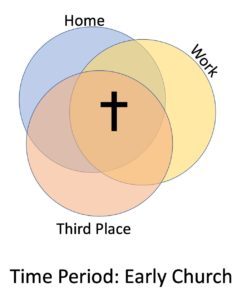 In the time of the early Church, home, work, and Third Place spheres were closely connected. Many social gatherings took place in the home and the marketplace, which were also workplace locations. Synagogues were also populated Third Places. And the Church flourished in all of them.
In the time of the early Church, home, work, and Third Place spheres were closely connected. Many social gatherings took place in the home and the marketplace, which were also workplace locations. Synagogues were also populated Third Places. And the Church flourished in all of them.
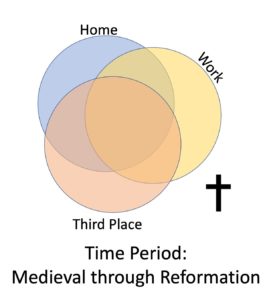 Upon the advent of church buildings and into the Reformation, the medieval Church separated itself from the home, work, and Third Place spheres. It wasn’t until the Reformation and Great Awakenings that the Church began to take hold of its new position as a Third Place.
Upon the advent of church buildings and into the Reformation, the medieval Church separated itself from the home, work, and Third Place spheres. It wasn’t until the Reformation and Great Awakenings that the Church began to take hold of its new position as a Third Place.
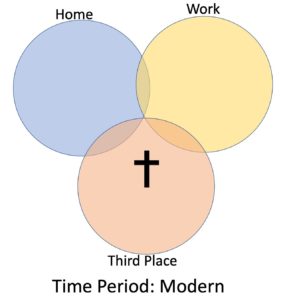 In fact, for the last several hundred years, church WAS a Third Place. In fact, it WAS a place more than a people in many folks’ understanding—the kirche, the building. In a Christendom culture, towns were designed around church properties, promising denominational representation and weaving church into the fabric of neighborhood structure and community life. Church was central to society and community, where many made friends, sought membership, and participated in potlucks, pasttimes, and social gatherings.
In fact, for the last several hundred years, church WAS a Third Place. In fact, it WAS a place more than a people in many folks’ understanding—the kirche, the building. In a Christendom culture, towns were designed around church properties, promising denominational representation and weaving church into the fabric of neighborhood structure and community life. Church was central to society and community, where many made friends, sought membership, and participated in potlucks, pasttimes, and social gatherings.
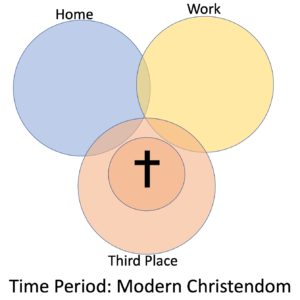 As society drifted away from Christendom and church became just one of many community and social connections, “seeker-sensitive” churches of the Church Growth movement (1980’s-1990’s) restructured their spaces to reflect the modern style of public buildings and other community gathering places. In effect, churches sought to BECOME Third Places once again, this time through physical alterations of their buildings.
As society drifted away from Christendom and church became just one of many community and social connections, “seeker-sensitive” churches of the Church Growth movement (1980’s-1990’s) restructured their spaces to reflect the modern style of public buildings and other community gathering places. In effect, churches sought to BECOME Third Places once again, this time through physical alterations of their buildings.
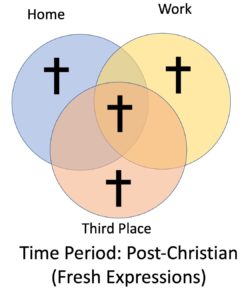 But then, in the increased distancing from Christendom and plunge into secular culture, the rise of the “nones” and “dones,” and an absence of church memory, the Church began to reformulate itself not by BECOMING but by GOING to existing Third Places and STAYING there to form Church. This is the essence of the Fresh Expressions movement, where the Church becomes incarnational and the Word “moves into the neighborhood.” In addition, First, Second, and Third Places have also converged once again, as the home becomes a workplace, as well as a Third Place. This drawing together of all three spheres was further exacerbated by the COVID-19 pandemic. Places have joined together in a way that somewhat resembles that of the time of the Early Church.
But then, in the increased distancing from Christendom and plunge into secular culture, the rise of the “nones” and “dones,” and an absence of church memory, the Church began to reformulate itself not by BECOMING but by GOING to existing Third Places and STAYING there to form Church. This is the essence of the Fresh Expressions movement, where the Church becomes incarnational and the Word “moves into the neighborhood.” In addition, First, Second, and Third Places have also converged once again, as the home becomes a workplace, as well as a Third Place. This drawing together of all three spheres was further exacerbated by the COVID-19 pandemic. Places have joined together in a way that somewhat resembles that of the time of the Early Church.
The Church began to reformulate itself not by BECOMING but by GOING to existing Third Places and STAYING there to form Church. This is the essence of the Fresh Expressions movement.
Tweet this.
But we must remember fresh expressions of church are not solely about places and spaces, though they may involve them. Starting a fresh expression of church is not just starting a worship service or Bible study in a tattoo parlor or restaurant or skatepark. Starting a fresh expression of church means “bringing the Church Jesus loves closer to the people Jesus loves,” whether in a brick and mortar location, through digital engagement, at home, at work, or all at the same time. If Starbucks and society are moving towards the creation of a new kind of Third Place, as well as an overlap among First, Second, and Third Places that somewhat resembles that of the Early Church, the opportunities for ministry and sharing the good news of Jesus are endless.
Post-Pandemic Expectations for Starting Church
So what might we expect as a result of this shift?
First, we must remember that Church can take place in all three Places. In Scripture, we’re reminded that Church can start in the home, in the marketplace, and in the places people meet up for fun, socialization, and community. And there will be new Third Places that arise—such as the automobile and its parades and social-distanced gatherings. Our job is to keep an eye out for them and to be attentive to what God might be calling us to do. If we truly believe in a God who transcends us, who is at work ahead of us, and who seeks to bring people to him through us, we must remember that Church can happen anywhere.
If we truly believe in a God who transcends us, who is at work ahead of us, and who seeks to bring people to him through us, we must remember that Church can happen anywhere.
Tweet this.
Second, Church may take place in multiple Places at the same time. A Third Place may exist as several people across the country, from their homes and backyards, join together for a Friday evening Zoom happy hour after working at home all day. This means Church can happen there too—at home and work and Third Place, together. Through the pandemic, many workplaces learned the cost-saving and efficient nature of their employees working from home—and they may not go back. This means more people working from home offices and desks, as well as eventually public areas, cafes, and coffee shops. One space becomes multiple. Forming Church there can potentially touch them all.
Third, the interconnectedness and overlap of Places may connect pioneers with whole groups of people they never might have met. As First, Second, and Third Places overlap, so do the people in them. The home not only connects family members but also becomes a Third Place for neighbors and friends. Doing ministry with people working remotely also taps into their families. In addition, physical gatherings may become a second connection point rather than a first. During the pandemic, the popular dating app Coffee Meets Bagel began hosting digital meetups for singles to meet, mingle, and connect, with the hope of making new friends and dates who would connect in-person at a later time.
While I do long for the day I can camp out once again in my favorite café, I also see great potential for ministry within the shift in First, Second, and Third Places we are experiencing. What could God lead us to next? Maybe Starbucks got it right– there is opportunity in every change and in every cultural shift.
